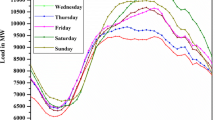Abstract
The importance of electrical load forecasting stems from energy planning and formulating strategies in power system. In this paper, a novel chaotic back-propagation (CBP) neural network algorithm based on the merit of Chebyshev map is proposed. To improve the accuracy of proposed algorithm, self-adaptive gradient correction method is used to eliminate the precocious phenomenon of network. An additional inertial term including chaotic sequence is increased in the process of optimizing the weight value and threshold value of network. The ergodicity of chaotic variables within the range of [−1, 1] can decrease the oscillation trend of network, accelerate the learning speed and overcome the fake saturation problem so as to greatly improve the forecasting ability of proposed algorithm. The simulation results of actual cases indicate that the proposed CBP neural network is advantageous in many respects in comparison with the previous methods studied.








Similar content being viewed by others
References
Lee W, Hong J (2015) A hybrid dynamic and fuzzy time series model for mid-term power load forecasting. Int J Electric Power Energy Syst 64:1057–1062
Cevik H, Cunkas M (2015) Short-term load forecasting using fuzzy logic and ANFIS. Neural Comput Appl 26:1355–1367
Zhou JZ, Fang RC, Li YH et al (2009) Parameter optimization of nonlinear grey Bernoulli model using particle swarm optimization. Appl Math Comput 207:292–299
Baseri H, Bakhshi-Jooybari M, Rahmani B (2011) Modeling of spring-back in V-die bending process by using fuzzy learning back-propagation algorithm. Exp Syst Appl 38:8894–8900
Efendi R, Ismail Z, Deris MM (2015) A new linguistic out-sample approach of fuzzy time series for daily forecasting of Malaysian electricity load demand. Appl Soft Comput 28:422–430
Zahedi G, Azizi S, Bahadori A, Elkamel A, Sharifah R, Alwi W (2013) Electricity demand estimation using an adaptive neuro-fuzzy network: a case study from the Ontario province—Canada. Energy 49:323–328
Zhai MY (2015) A new method for short-term load forecasting based on fractal interpretation and wavelet analysis. Int J Electric Power Energy Syst 69:241–245
Sudheer G, Suseelatha A (2015) Short term load forecasting using wavelet transform combined with Holt-Winters and weighted nearest neighbor models. Int J Electric Power Energy Syst 64:340–346
Zhang XY, Zeng XX, Luo B, Pan LQ (2014) On some classes of sequential spiking neural P systems. Neural Comput 26(5):974–997
Dong J, Zheng C, Kan G, Zhao M, Wen J, Yu J (2015) Applying the ensemble artificial neural network-based hybrid data-driven model to daily total load forecasting. Neural Comput Appl 26:603–611
Hsu CF (2013) A self-evolving functional-linked wavelet neural network for control applications. Appl Soft Comput 13(11):4392–4402
Hsu CF, Lin CM, Yeh RG (2013) Supervisory adaptive dynamic RBF-based neural fuzzy control system design for unknown nonlinear systems. Appl Soft Comput 13(4):1620–1626
An X, Jiang D, Zhao M, Liu C (2012) Short-term prediction of wind power using EMD and chaotic theory. Commun Nonlinear Sci Numer Simulat 17:1036–1042
Sheikhan M, Hemmati E (2012) Transient chaotic neural network-based disjoint multipath routing for mobile ad-hoc networks. Neural Comput Appl 21:1403–1412
Akritas P, Antoniou I, Ivanov VV (2000) Identification and prediction of discrete chaotic maps applying a Chebyshev neural network. Chaos Soliton & Fract. 11:337–344
Liao X, Li X, Peng J, Chen G (2004) A digital secure image communication scheme based on the chaotic Chebyshev map. Int J Commun Syst 17:437–445
Xiao D, Liao XF, Deng XJ (2007) A novel key agreement protocol based on chaotic maps. Inform Sci 177:1136–1142
Xiao D, Liao XF, Deng XJ (2008) Using time-stamp to improve the security of a chaotic maps-based key agreement protocol. Inform Sci 178:1598–1602
He YY, Zhou JZ, Xiang XQ, Chen H, Qin H (2009) Comparison of different chaotic maps in particle swarm optimization algorithm for long term cascaded hydroelectric system scheduling. Chaos Soliton Fract 42(5):3169–3176
EUNITE network (2001) http://neuron.tuke.sk/competition/index.php
Zhai YJ, Liu L, Wang P (2012) Mid-term load forecasting based on ADE-SVM and fuzzy theory. Power Syst Prot control 40(8):110–115
He YY, Xu QF, Yang SL, Yu BG (2013). A power load probability density forecasting method based on RBF neural network quantile regression. In Proceedings of the CSEE 33(1), 93–98
Liu R, Fang GF (2012) Short-term load forecasting with comprehensive weather factors based on improved Elman neural network. Power Syst Protect Control 40(22):113–117
Selakov A, Cvijetinovic D, Milovic L, Mellon S, Bekut D (2014) Hybrid PSO–SVM method for short-term load forecasting during periods with significant temperature variations in city of Burbank. Appl Soft Comput 16:80–88
Hu Z, Bao Y, Xiong T (2014) Comprehensive learning particle swarm optimization based memetic algorithm for model selection in short-term load forecasting using support vector regression. Appl Soft Comput 25:15–25
Bahrami S, Hooshmand RA, Parastegari M (2014) Short term electric load forecasting by wavelet transform and grey model improved by PSO (particle swarm optimization) algorithm. Energy 72:434–442
He YY, Xu QF (2012) Short-term power load forecasting based on self-adapting PSO-BP neural network model. In: Proceedings—4th international conference on computational and information sciences, pp 1096–1099
Acknowledgments
This paper is funded by the National Natural Science Foundation (No.71401049), the Anhui Provincial Natural Science Foundation (No.1408085QG137, 1408085MG136), the CRSRI Open Research Program (Program SN CKWV2014213/KY), the Open Research Fund of State Key Laboratory of Simulation and Regulation of Water Cycle in River Basin(China Institute of Water Resources and Hydropower Research, Grant NO IWHR-SKL-201605), and the Specialized Research Fund for the Doctoral Program of Higher Education (No. 20130111120015).
Author information
Authors and Affiliations
Corresponding author
Rights and permissions
About this article
Cite this article
He, Y., Xu, Q., Wan, J. et al. Electrical load forecasting based on self-adaptive chaotic neural network using Chebyshev map. Neural Comput & Applic 29, 603–612 (2018). https://doi.org/10.1007/s00521-016-2561-8
Received:
Accepted:
Published:
Issue Date:
DOI: https://doi.org/10.1007/s00521-016-2561-8




